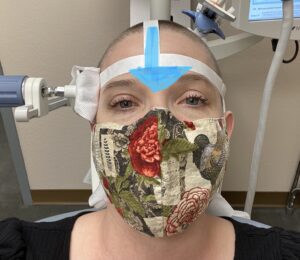Brain mapping. Frankly, I didn’t know exactly what to expect and the sound of it was terrifying. In reality, it was no big deal.
TMS targets the dorsolateral prefrontal cortex, which is the area of the brain that is most known for executive functions like working memory, decision making, and motor planning. It’s also connected to other parts of the brain that are responsible for releasing neurotransmitters like dopamine and serotonin. When we’re depressed, our brains become less active, and apparently the dorsolateral prefrontal cortex is even more affected than other areas of the brain. I found this information here.
Brain mapping only took about 20 minutes. They sat me in a slightly reclining chair like a dentist’s chair. The doctor put a strip of paper on my head that was shaped like an arrow. This was so they knew where the center of my head was and could line everything up. I had a bit of an Aang from Avatar thing going.

Aang from Avatar

Look, Ma, I’m an Airbender!
Then they had me loosely hold my right hand with my thumb out like I was casually hitchhiking. (PSA: Never casually hitchhike.) They started magnetic pulses on the left side of my head, which made my fingers twitch. They were trying to isolate my thumb and see what level they needed to use in order to be effective. After they find the right area on the brain that triggers the thumb, they use that as a reference point to find the exact area where they want to focus the treatment. No thumbs will be twitching for the rest of the treatment, which is a relief. It’s strange to have something go off by your head and see and feel your hand react on the other side of your body. It also makes me look at depression in a different way. There really is so much physiologically involved in depression. It definitely isn’t situational only.

Brain mapping only took about 20 minutes, and it wasn’t uncomfortable. We were able to start the first treatment right after that. I’ll share more on that later.
Overview: Brain mapping was easy, painless, and although I had a slight flash of anxiety when they were reclining my chair (what did I get myself into?!) it was a positive experience.
You can read my previous post about TMS therapy here.


4 Comments on “Transcranial Magnetic Stimulation Therapy: Brain Mapping”
Thanks so much for sharing about this journey. The human brain is an amazing thing, and there’s still so much we have to learn about depression and anxiety. I look forward to your findings.
Sounds fascinating! Looking forward to the next update.
Wow, I had no idea that transcranial magnetic therapy uses magnetic pulses to treat depression and make those intrusive thoughts go away. I wanted to learn more about this topic after seeing flyers that offer this around my home. I’ll keep this in mind if ever I end up needing this someday.
I just did my second round, and it is still a lifesaver. I’m glad you can keep this in your back pocket for future use if necessary.